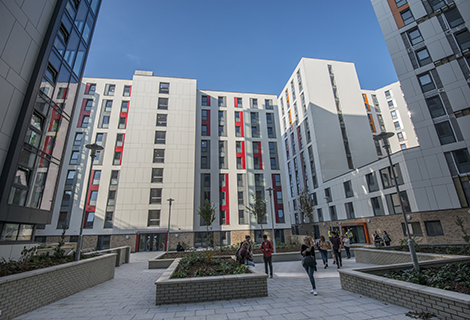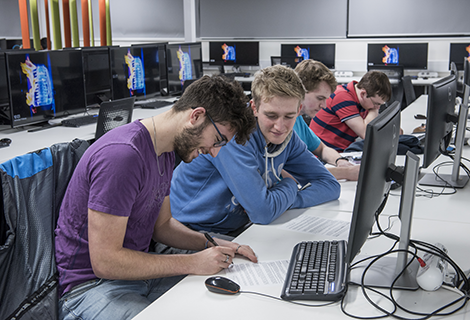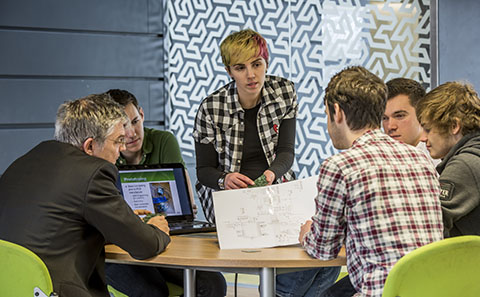
Research excellence
100% of our Computer Science research impact is world-leading or internationally excellent

100% of our Computer Science research impact is world-leading or internationally excellent

We offer full-time registered undergraduate and international postgraduate students a place in halls during their first year of study.

For full details about specialist pathways and module options, take a look at the individual programme pages.
Find out more
Smart human-machine interaction as a global challenge connects electronics and computer science with other disciplines such as psychology, sociology and the arts. Digital Musical Instruments (DMI) require the accurate capture of performersââ¬â¢ real-time expressive actions and the mapping of these onto sound production parameters. These demands make DMIs very good test beds for novel human-machine interaction technologies. For instance, there is an expectation from musicians to have an electronic orchestra in their hands, and perform music not only by hearing, seeing but also touching and feeling. In collaboration with the Department of Music (Dr Richard Polfreman), this project is to build a smart musical instrument using microsystems and sensor systems (such as micro-sensors, embedded system, wireless, 3D printing, wearable electronics, etc.) to trial novel human-machine interaction methods.
If you are interested in the project, please contact J.Yan@soton.ac.uk
For the UK to meet legally binding renewable targets by year 2020 and beyond, a series of wind farms are under construction, and more new projects are being developed. The offshore grids and their connection to the existing transmission systems can only be realised using the HVDC links. Using high voltage will make power transmission more efficient and the only feasible solution is to use extreme upgrades to existing plant. Cables, the key part of the HVDC links, will be forced to operate well beyond their existing limits (currently about +/-500 kV and 1000 MW). This means that both cable insulation and operating conditions have to be pushed far beyond the limits currently considered acceptable. Therefore, a fundamental understanding of the performance of the insulation and the development of novel operating methodologies are urgently required to meet the challenges. This project will investigate the impact of inherent defects, space charge dynamics, partial discharges, electrical tree and power quality on electrical performance of highly stressed lapped cable insulation and develop novel operating methodologies that take account of the influence of the above factors to achieve reliable and safe operation for the HVDC links.
Mesenchymal stem cells (MSCs) can be isolated from the bone marrow and may be used for regenerative medicine applications because they can differentiate into fat, cartilage and bone cells. However, MSCs constitute less than 1% of the bone marrow mononuclear cell population, which presents challenges for their isolation and characterization. Moreover, these stem cells are heterogeneous, displaying variable potential for proliferation and differentiation, which complicates studies with conventional assays. In this project, we use a microfluidic cell trap device to array large numbers of MSCs for single-cell optical imaging. Immunolabelling of surface markers will be used to identify MSC subpopulations, while exposure to signalling pathway activators will yield information on the differentiation potential of specific MSC sub-types. The ultimate aim is to formulate drug carriers that are able to trigger the differentiation of susceptible stem cells into desired tissue, for example to enhance bone mass to reduce fracture risk, or to facilitate bone fracture healing.
The understanding of transient wave dynamics spectra on solid and/or permeable structures is of paramount importance for manufacturing and designing new material for the next generation of coastal defences in the UK. The observed sea rises and more frequent severe storms due to climate change are exposing our coastal defences to serious damage, induced casualties and huge economic costs. The rigorous simulation of the dynamics of the flow prior to, at and after impact at complex structures and the understanding of their response in a more systematic way needs to be investigated. However, this represents a great fluid dynamics simulation with intensive computations as the structure of the porous medium gets complex. In this PhD work, free surface flow simulations, analyses of forces of impact, and the integrity and responses of structures to transient impulsive signals with compressed air bubbles will be investigated. Distributed computing intensive simulations will be achieved to discover optimised designs of resilient porous structures of the future.
The project focusses on developing preliminary protocols for the processing of wireline and geological big data, then train specialised machine learning lithology classifiers. The classifiers shall automatically interpret borehole wireline logs from a well characterized borehole into the upper oceanic crust with targeted high Correct Classification Rates (CCRs>90%). They should be trained to successfully generalize in their lithology classifications when tested against geological knowledge based on drill core observations. The achievement of best lithology classification can be reached through accurate matching of the big data generated from wireline logging and core recoveries. Such correct data modelling by the classifiers can be achieved only through strong understanding of the domain knowledge for the labelling of the training datasets. The big data concerned in the learning experiments can be semi-structured and multi-spectral in most cases. Hence it exhibits high complexity, unbalancing, asynchronicities and more likely some gaps. Machine learning approaches for lithology classification techniques may need to be supported by additional domain knowledge reasoning models based on fuzzy logic to overcome persistent mis-classifications (low CCRs). In recent years (Sabeur et al, 2013, 2015) have worked on operational drilling data, under the TRIDEC (2010-2013) project, with optimised classifiers that sustain big data complexity, unbalancing and classes inseparability challenges.
G. V. Veres and Z. A. Sabeur (2015). Data Analytics for Operational Drilling States Classifications. 23rd European Symposium on Artificial Neural Networks, In Computational Intelligence and Machine Learning, 22nd -24th April 2015, Bruges, Belgium. ISBN 978-287587014-8.
G. V. Veres and Z. A. Sabeur (2013). Automated operational states detection for drilling systems control in critical conditions. 21st European Symposium on Artificial Neural Networks, Computational Intelligence and Machine Learning, 24th-26th April 2013, Bruges, Belgium.